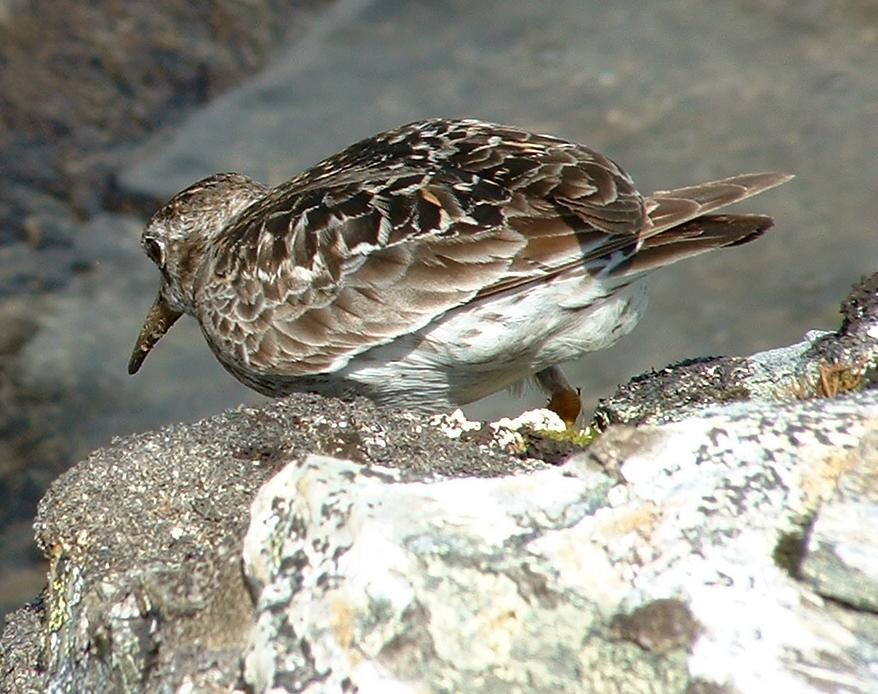Purple Sandpiper
A species of Calidris, Also known as Winter Snipe Scientific name : Calidris maritima Genus : Calidris
Purple Sandpiper, A species of Calidris
Also known as:
Winter Snipe
Botanical name: Calidris maritima
Genus: Calidris
Description
The purple Sandpiper is a small-sized shorebird with a distinctive, stocky build and mottled brown and gray plumage. It inhabits rocky shorelines and offshore islands along the northern coasts of the Atlantic Ocean. The Purple Sandpiper feeds on small crustaceans and other shoreline invertebrates. During migration, it travels along the northern coasts of the Atlantic Ocean and can be found in large flocks. 
Size
23 cm
Colors
Gray
White
Life Expectancy
8 years
Nest Placement
Ground
Clutch Size
3 - 4 eggs
Feeding Habits
Purple Sandpiper's diet consists primarily of invertebrates found on rocky shorelines. They visually or tactilely forage for mussels, periwinkles, sea snails, worms, small crabs, and crustaceans, often probing among barnacles and algae. Consuming both aduIlt and larval kelp flies, purple Sandpiper also ingests marine algae, adapting to eat spiders, worms, aphids, beetles, and various Arctic flora in tundra breeding grounds.
Habitat
Purple Sandpiper's habitat spans from arctic tundra breeding grounds with stony plateaus and rich vegetation to coastal regions featuring rocky shorelines. They are well-adapted to cold climates, residing in northern marine environments during winter. Their foraging extends from damp tundra to marine shorelines, with some overwintering in unfrozen river areas.
Nest Behavior
Purple Sandpiper males create several scrapes for female selection. Nest-building occurs in tundra habitats, with the female choosing the final site. After laying eggs, both parents partake in the care for the eggs and young.
Nest Characteristics
The purple Sandpiper's nest is a scrape or depression on tundra ground, concealed by brushy cover. It is cup-shaped, approximately 3.7 inches wide and 1.3 inches high, lined with feathers, sedges, willow leaves, mountain avens, or arctic bell-heather.
Dite type
Aquatic invertebrate eater
People often ask
Migration Overview
In Britain, these birds occur in winter in good numbers principally along the east and south coasts, where they favour rocky shorelines adjacent to the sea. It is much rarer as a breeding bird, found only in a localised area of the Cairngorms National Park, where 1–3 pairs have bred since the 1970s. Records of breeding by this species in the UK are monitored and archived by the Rare Breeding Birds Panel. They are late migrants and move to rocky, ice-free Atlantic coasts in winter. Most go no further south than North Carolina and northern Portugal. They are fairly gregarious, forming small flocks, often with Ruddy Turnstones. This species is tame and approachable. 
General Info
Feeding Habits
Bird food type
Behavior
Purple Sandpiper exhibit distinctive behaviors, especially during their breeding season. Males perform territorial displays, which include flight performances paired with a melodious song, and simulate nest-building as part of courtship. They practice monogamy, with long-term bonds and shared incubation responsibilities, though females leave just before hatching. Unlike other shorebirds, this leaves males to solely rear the young. Purple Sandpiper display site fidelity, with males returning to the same territories annually. In non-breeding seasons, they congregate in sociable groups, mingling with similar shorebirds within their habitat constraints.
Species Status
Not globally threatened.
Scientific Classification
Phylum
Chordates Class
Birds Order
Shorebirds Family
Sandpipers Genus
Calidris Species
Purple Sandpiper 